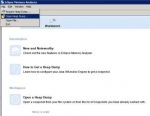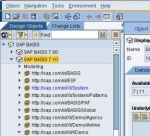SAP PI (Process Integration)
Definition or Meaning -What is SAP PI?
Full form or SAP PI stands for (Process Integration). We all must have come across a middleman once in our lifetime. What does a middleman do? In simple words if we say, a middleman connects or integrates two or more different necessary parties required to do certain task for their mutual benefits. If we talk about SAP PI it stands for process integration. Think of it as that middleman who has a connection with different part of a society. He helps different parts of the organization adjust meeting at certain place. All the coordination, communication is done by him because he has connection with all the different sectors.
As the name suggests SAP PI is a tool for the integration of different Sap and Non SAP systems. It facilitates cross system communication and permits the connection between SAP and Non sap systems on the basis of a wide range of programing languages such as ABAP and JAVA. Its work is to offer an open source environment for integrating systems which a complex system requires. Being a middleware it increases the pace of integration of SAP and non-SAP systems within or outside the organization.
Let’s say you are working on SAP ERP framework and you need to integrate with a different framework let’s say CRM. Using two different device or frameworks for even a petty chore can be quite hectic for engineers and association both. SAP PI does the work of keeping all the diverse association in a single place making it easy to synchronize information between various frameworks.
How SAP PI works?
As mentioned above, SAP PI’s work is to integrate different SAP or non-SAP solutions. To do so it has to make a lot of connection, coordination and communication. Sap Pi has basically three fundamental duties which it is supposed to do. It connects, coordinates and communicates with the different parts of a system or outside the system whose integration is required or necessary. Using the help of connector/ Adapter system, it is able to indulge in even 3rd party solutions and not necessarily only SAP solutions. Apart from connecting, it makes sure that the message gets accurately conveyed from the source to the objective goal by providing a way for every coordinated business exchange. The most important work is to communicate. It helps in the interpretation of the documents by translating files into any required format regardless of the fact that it is internal file or any business to business integration standard.
New Features in SAP PI
- SAP solutions have been providing new features in almost every of its product.
- SAP PI is not an exception as they have added a lot of cool features to this tool like centralized monitoring, large file to file transfer, IDOC and HTTP adapters in AAE and Automated Transport for Schema Validation and many others.
- By the help of centralized monitoring, it becomes easier to address the issues arisen more quickly and efficiently.
- Centralized monitoring system provides unified alert of notifications and status of PI components from a single entry point.
- Earlier SAP PI was not strong enough to handle large sized file. Handling of big files caused other integration to run at much slower pace and also the file size could not be of larger than memory size.
- The new feature in SAP PI fixes this thing and now we can transfer even big files without causing any trouble.
- In the new feature, TREX server has been replaced with UDS I.e. user defined search. It has more flexible options to configure filters and search criteria.
- There are other cool features like time out configuration per communication channel and user centric perspectives in the ESR have been provided.
- Apart from these features, certain Add-on like secure connectivity, B2B add-ons have also been provided for the benefit of users.
Advantages of SAP PI
- Talking about the advantages of Sap solutions, it certainly is beneficial for the user as well as the organization also.
- Since it is able to integrate with non-SAP systems, it can access to a centralized database facilitating fast implementation of quality enterprise plans.
- SAP PI helps in maintaining and updating information by generating accurate reports on time.
- Apart from these SAP PI solutions because it works on a centralized administration platform, enhances the ability to circulate information across organizations.
Tutorials
 Connecting SFTP Server from SAP HCI (HANA Cloud Integration)
Connecting SFTP Server from SAP HCI (HANA Cloud Integration)
How to connect SFTP Server from HCIExchanging files is a very common scenario. You may have files to exchange that contain your HR data or your finance data and so and so forth or there may be legacy ... SAP PI (Process Integration) Certification Cost and Course Duration in India
SAP PI (Process Integration) Certification Cost and Course Duration in India
SAP Process Integration (PI) Courses The SAP NetWeaver Process Integration course is a program consisting of virtual classrooms that cover different scenarios of Process Integration in SAP System i ... Receiver Determination Enhancement
Receiver Determination Enhancement
Aware of File-to-File Scenario using Standard Receiver Determination. Standard Receiver determination: In the standard receiver determination, we used XPath to find out the Receivers in the Cond ...- Use of Staging in Process Integration (PI)
How and when to use Staging in SAP Process Integration (PI)?Staging should only be used for asynchronous message processing and not for synchronous interfaces. In general staging should be used when t ... - Use of Logging in Process Integration (PI)
How and when to use Logging in SAP Process Integration (PI)?In general Logging used for message processing if there is a business requirement to store additional versions of the payload for later moni ... - How to Update PI Support Package Stack (SPS)?
We are updating the Support Package Stack (SPS) in our Process Integration (PI) or Process Orchestration (PO) system via Solution Managers Maintenance Optimizer (MOPZ)By default MOPZ does not include ...  Configure driver level encryption in PI JDBC Adapter
Configure driver level encryption in PI JDBC Adapter
How to configure driver level encryption in PI JDBC AdapterWhile attempting to configure SSL encryption with the help of third party database e.g Oracle, MS SQL to the Process Integration (PI)/Process ... Check Version of HCI Server
Check Version of HCI Server
How to check the HCI (HANA Cloud Integration ) tenant/server vesrion?Answer:There are two ways to check the version of HCI server or tenant: via Eclipse via WebUINote: But both of them at least ... Error 'Transaction program not registered' during connection test of Java Idoc adapter
Error 'Transaction program not registered' during connection test of Java Idoc adapter
While doing the connection test of the RFC destination in receiver or sender ABAP system, getting an error 'Transaction program not registered'. We are using the Java Idoc adapter.Please maint ... Difference between Support Pack and Patch in SAP PI
Difference between Support Pack and Patch in SAP PI
Support Pack vs Patch What is the difference between support pack and patch in SAP PI? SOLUTION Support Package Stack A Support Package Stack (SP) is a collection of bug fix ... PI Table SXMSCLUP Grow Rapidly
PI Table SXMSCLUP Grow Rapidly
Issue: Table SXMSCLUP is growing rapidly and consuming too much disc space. Why this problem occurred This issue occurred because logging is turned on for asynchronous or synchronous me ... Check if logical ports exist in SOAMANAGER
Check if logical ports exist in SOAMANAGER
How to check if logical ports exist in SOAMANAGER?SOLUTIONPlease follow the steps below in order to check if logical ports exist in SOAMANAGER:1) First, run the t-code SOAMANAGER.2) Then click on the ...- Starting and Stopping SAP PI System
You want to shutdown the PI system and are unsure regarding the correct sequence in which the components should be shut down and then started. The Technical Operational Manual for PI doesn&r ...  Self analyze Heap Dump using MAT
Self analyze Heap Dump using MAT
How to self-analyze Heap Dump using MAT?SOLUTIONPlease follow the steps below in order to self-analyze Heap Dump using MAT:1) First please download the Eclipse Memory Analyzer tool. It will be used to ...- Enable compression on PI/PO system
How to enable compression on PI/PO system?As we know that the PI/PO system process millions of asynchronous messages every day. And also it becomes difficult for the customer to decrease the retention ... - SAP PI Performance Check
If the performance of your SAP PI system is not up to par and does not meet the performance requirements. This tutorial helps the user to analyse the performance problem. The end user the Process I ...  Check Patch level of PI ESR contents
Check Patch level of PI ESR contents
How to check the patch level of PI ESR contents? This tutorial explains how to check the Patch Level of the PI SAP Basis ESR content / SFTP ADAPTER XI CONTENT. SOLUTION: First Call t ...- Using J2EE Cluster in SAP PI 7.3 Environment
How to configure a J2EE cluster for PI 7.3* system to achieve better performance in the Java components? SOLUTION Listed below are the two general approaches for the configuration of more J2EE s ... - Scaling Up Large PI Installations
On each instance, the user is running a large SAP PI installation with multiple application servers and multiple server nodes. The user would have to scale up his environment because of the expected i ... - SAP Services for PI and XI
This tutorial explains preparations required to execute SAP remote and onsite services for SAP Process Orchestration/Process Integration (PI)/Exchange Infrastructure(XI). Preparations 1. Connect ...